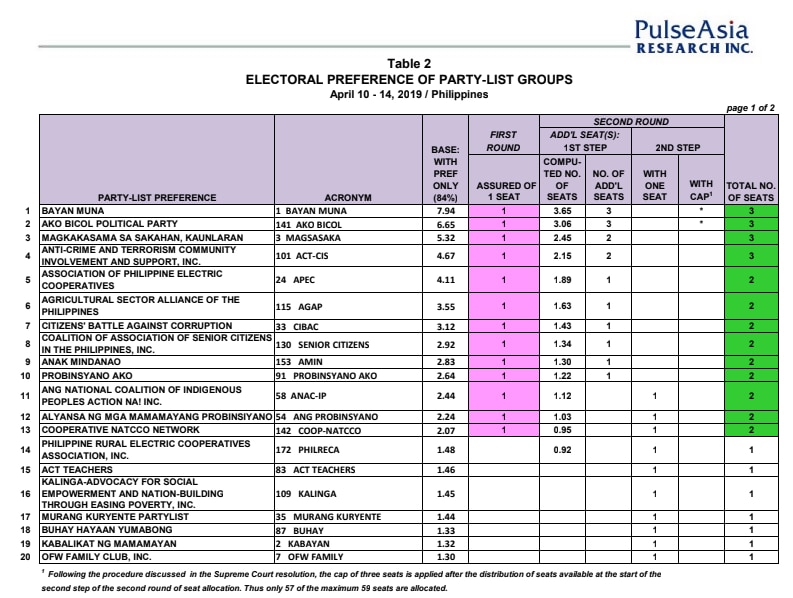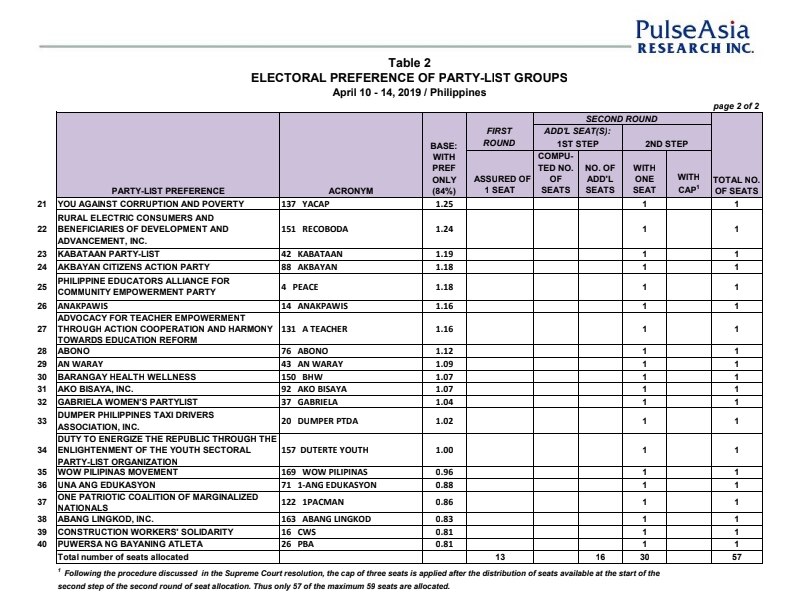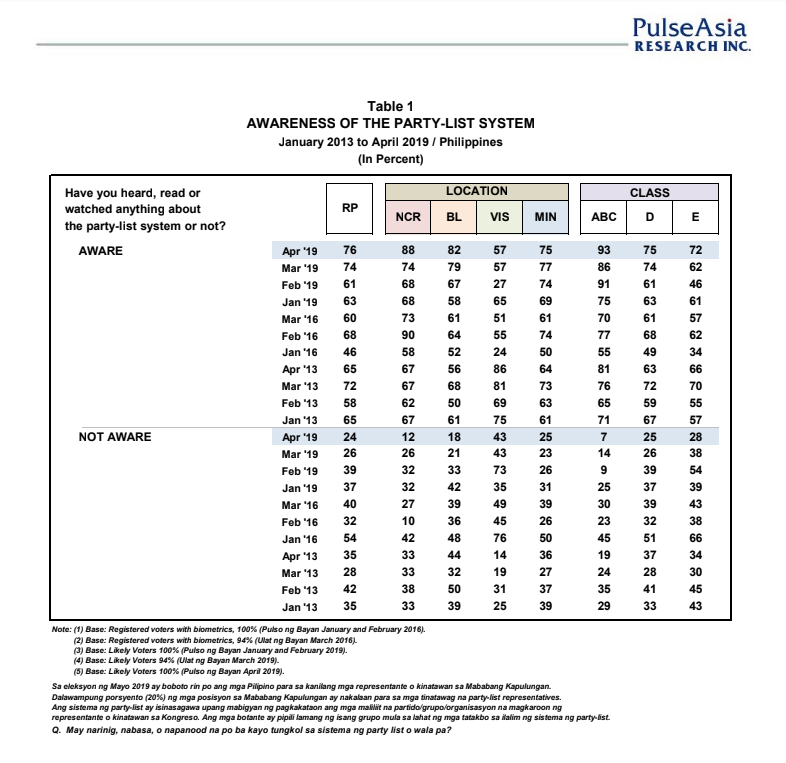13 of 134 party-lists likely to secure Congress seats in May polls: Pulse Asia | ABS-CBN
ADVERTISEMENT

Welcome, Kapamilya! We use cookies to improve your browsing experience. Continuing to use this site means you agree to our use of cookies. Tell me more!
13 of 134 party-lists likely to secure Congress seats in May polls: Pulse Asia
13 of 134 party-lists likely to secure Congress seats in May polls: Pulse Asia
ABS-CBN News
Published May 03, 2019 12:53 PM PHT
|
Updated May 03, 2019 03:02 PM PHT
MANILA - Thirteen of the 134 party-lists registered in the midterm polls could secure Congressional seats as only three-fourths of voters are aware of the party-list system, a Pulse Asia survey released Friday showed.
MANILA - Thirteen of the 134 party-lists registered in the midterm polls could secure Congressional seats as only three-fourths of voters are aware of the party-list system, a Pulse Asia survey released Friday showed.
Less than 10 percent of the total number of registered party-lists in the May 2019 polls garnered over 2-percent of votes, the minimum voter support requirement to earn at least one seat in the next Congress, Pulse Asia's survey conducted from April 10-14 showed.
Less than 10 percent of the total number of registered party-lists in the May 2019 polls garnered over 2-percent of votes, the minimum voter support requirement to earn at least one seat in the next Congress, Pulse Asia's survey conducted from April 10-14 showed.
Bayan Muna, a left-leaning group that has been critical of President Rodrigo Duterte's policies, topped the poll with 7.94 percent, followed by Ako Bicol Political Party with 6.65 percent, Magsasaka with 5.32 percent, and Anti-Crime and Terrorism Community Involvement and Support, Inc. with 4.67 percent.
Bayan Muna, a left-leaning group that has been critical of President Rodrigo Duterte's policies, topped the poll with 7.94 percent, followed by Ako Bicol Political Party with 6.65 percent, Magsasaka with 5.32 percent, and Anti-Crime and Terrorism Community Involvement and Support, Inc. with 4.67 percent.
All 4 party-lists have the statistical chance of having 3 representatives in Congress, the maximum number of seats a party-list is allowed to have under the law.
All 4 party-lists have the statistical chance of having 3 representatives in Congress, the maximum number of seats a party-list is allowed to have under the law.
ADVERTISEMENT
Other party-lists that breached the 2 percent minimum vote, and could have at least 2 seats in Congress are:
- Association of Philippine Electric Cooperatives (4.11 percent)
- Agricultural Sector Alliance of the Philippines (3.55 percent)
- Citizens’ Battle Against Corruption (3.12 percent)
- Coalition of Association of Senior Citizens in the Philippines, Inc. (2.92 percent)
- Anak Mindanao (2.83 percent)
- Probinsyano Ako (2.64 percent)
- Ang National Coalition of Indigenous Peoples Action Na! Inc. (2.44 percent)
- Alyansa ng mga Mamamayang Probinsiyano (2.24 percent)
- Cooperative NATCCP Network (2.07 percent)
Other party-lists that breached the 2 percent minimum vote, and could have at least 2 seats in Congress are:
- Association of Philippine Electric Cooperatives (4.11 percent)
- Agricultural Sector Alliance of the Philippines (3.55 percent)
- Citizens’ Battle Against Corruption (3.12 percent)
- Coalition of Association of Senior Citizens in the Philippines, Inc. (2.92 percent)
- Anak Mindanao (2.83 percent)
- Probinsyano Ako (2.64 percent)
- Ang National Coalition of Indigenous Peoples Action Na! Inc. (2.44 percent)
- Alyansa ng mga Mamamayang Probinsiyano (2.24 percent)
- Cooperative NATCCP Network (2.07 percent)
Under the law, 59 seats in Congress would be allocated for party-list representatives.
Under the law, 59 seats in Congress would be allocated for party-list representatives.
Despite the existence of the party-list system since 1995, only 76 percent of Filipino registered voters have heard, read, or watched something about the party-list system, Pulse Asia said.
Despite the existence of the party-list system since 1995, only 76 percent of Filipino registered voters have heard, read, or watched something about the party-list system, Pulse Asia said.
Voters from Metro Manila and the rest of Luzon were more aware of the marginal representation system with 88 percent and 82 percent awareness respectively.
Voters from Metro Manila and the rest of Luzon were more aware of the marginal representation system with 88 percent and 82 percent awareness respectively.
At least 75 percent of voters from Mindanao said they were aware of the party-list system while only half of voters from Visayas (57 percent) knew about it.
At least 75 percent of voters from Mindanao said they were aware of the party-list system while only half of voters from Visayas (57 percent) knew about it.
ADVERTISEMENT
Some 1,800 registered voters took part in the survey that had an error margin of +/- 2.3 percent and 95 percent confidence level.
Some 1,800 registered voters took part in the survey that had an error margin of +/- 2.3 percent and 95 percent confidence level.
The party-list law was crafted to ensure that marginalized groups would be well-represented in Congress.
The party-list law was crafted to ensure that marginalized groups would be well-represented in Congress.
"Iyun ang pinaka-purpose bakit nagkaroon ng party-list, kasi sabi nga natin, ito yung mga marginalized sector, hindi napapansin, maliit ang makinarya nila, kaya sila binigyan ng ganitong pagkakataon kasi para ma-represent niyo 'yung supposed to be members niyo," lawyer Claire Castro told DZMM in an earlier interview.
"Iyun ang pinaka-purpose bakit nagkaroon ng party-list, kasi sabi nga natin, ito yung mga marginalized sector, hindi napapansin, maliit ang makinarya nila, kaya sila binigyan ng ganitong pagkakataon kasi para ma-represent niyo 'yung supposed to be members niyo," lawyer Claire Castro told DZMM in an earlier interview.
(The main purpose of party-lists is to represent the marginalized sector that has been neglected. Groups from this sector usually have small political machineries that's why we are giving them an opportunity to field their own representatives.)
(The main purpose of party-lists is to represent the marginalized sector that has been neglected. Groups from this sector usually have small political machineries that's why we are giving them an opportunity to field their own representatives.)
"Para kung ano man 'yung advocacy ng grupo ninyo, ay maidulog niyo sa Congress at makakagawa kayo ng magandang batas para sa welfare ng mga miyembro ninyo," dagdag ni Castro.
"Para kung ano man 'yung advocacy ng grupo ninyo, ay maidulog niyo sa Congress at makakagawa kayo ng magandang batas para sa welfare ng mga miyembro ninyo," dagdag ni Castro.
ADVERTISEMENT
(Whatever their advocacy is, they could raise it in Congress and craft laws for the welfare of their members.)
(Whatever their advocacy is, they could raise it in Congress and craft laws for the welfare of their members.)
Political analysts, however, noted that the party-list system has already been hijacked by political dynasties.
Political analysts, however, noted that the party-list system has already been hijacked by political dynasties.
Political families--or families that have produced more than one elected or appointed official--have fielded 49 party-list nominees in the May elections.
Political families--or families that have produced more than one elected or appointed official--have fielded 49 party-list nominees in the May elections.
If all of these nominees from political clans win a seat in the 2019 midterm polls, they could occupy 83 percent of the 59 party-list seats in the House of Representatives.
If all of these nominees from political clans win a seat in the 2019 midterm polls, they could occupy 83 percent of the 59 party-list seats in the House of Representatives.
ADVERTISEMENT
ADVERTISEMENT





